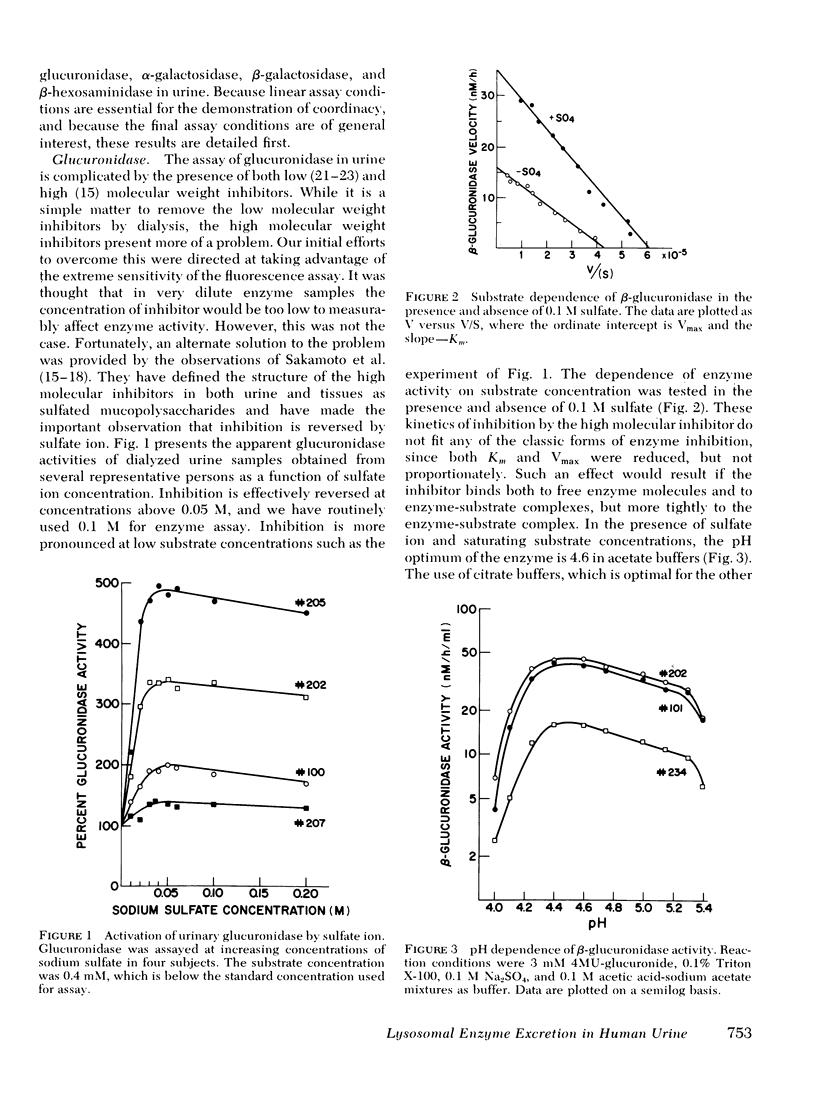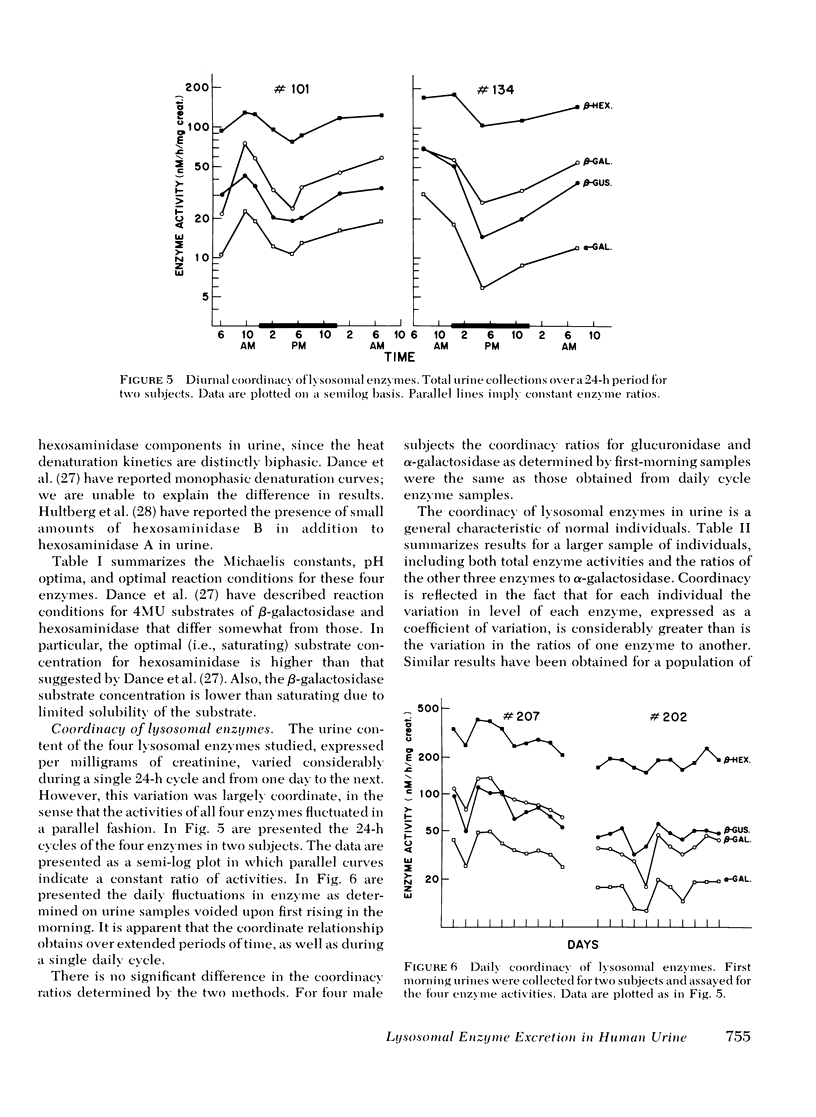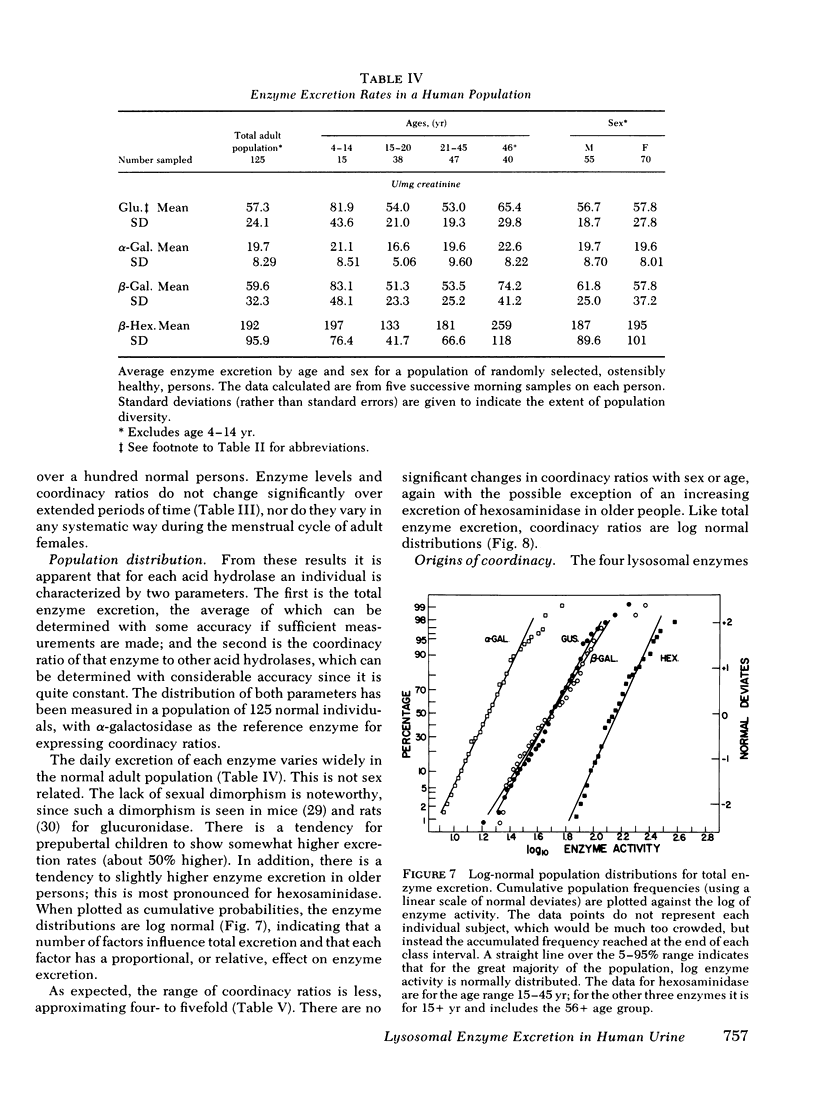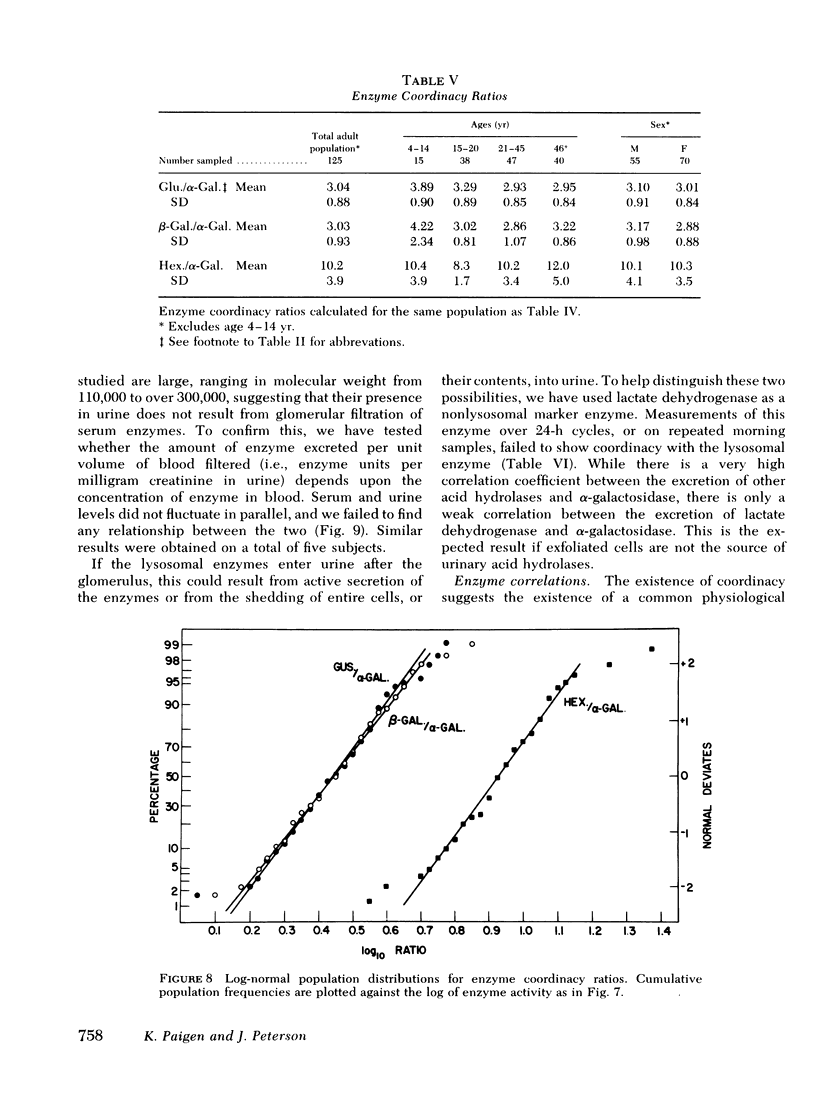Abstract
Assay conditions have been developed for the determination of urinary beta-glucuronidase, beta-galactosidase, alpha-galactosidase, and beta-hexosaminidase using fluorometric substrates. The assay conditions for beta-glucuronidase overcome interference by both low and high molecular weight inhibitors, a problem that has confused earlier studies of enzyme excretion. The four lysosomal enzymes are excreted corrdinately: although their absolute levels (in units per milligram of creatinine) vary during the day and from one day to the next, the ratio of one enzyme to another remains relatively constant. The lack of correlation betweem plasma and urine enzyme levels, together with the high molecular weights of these enzymes, suggests that the urinary enzymes are not derived by glomerular filtration. The lack of coordinacy with lactate dehydrogenase suggests they are not derived from exfoliated cells. by analogy with experimental animals, they may be derived from lysosomes extruded into the lumen of the proximal tubule by epithelial cells. There is considerable variation among a population of 125 healthy adult subjects for total enzyme excretion. Both total enzyme excretion and coordinacy ratios are log-normally distributed, suggesting that they are the resultants of many factors, each of which has a relative, or proportional, effect on enzyme excretion. About one-half the population variation resides in a process common to the excretion of all four enzymes (possibly the lysosome extrusion pathway), and about one-half resides in factors affecting each enzyme independently.
Full text
PDF











Selected References
These references are in PubMed. This may not be the complete list of references from this article.
- BANK N., BAILINE S. H. URINARY BETA-GLUCURONIDASE ACTIVITY IN PATIENTS WITH URINARY-TRACT INFECTION. N Engl J Med. 1965 Jan 14;272:70–75. doi: 10.1056/NEJM196501142720203. [DOI] [PubMed] [Google Scholar]
- BOYLAND E., GASSON J. E., WILLIAMS D. C. Enzyme activity in relation to cancer; the urinary beta-glucuronidase activity of patients suffering from malignant disease. Br J Cancer. 1957 Mar;11(1):120–129. doi: 10.1038/bjc.1957.18. [DOI] [PMC free article] [PubMed] [Google Scholar]
- BOYLAND E., WALLACE D. M., WILLIAMS D. C. The activity of the enzymes sulphatase and beta-glucuronidase in the urine, serum and bladder tissue. Br J Cancer. 1955 Mar;9(1):62–79. doi: 10.1038/bjc.1955.6. [DOI] [PMC free article] [PubMed] [Google Scholar]
- Begum A. Urinary excretion of beta-glucuronidase in protein-calorie malnutrition. Clin Chim Acta. 1973 Jul 14;46(3):229–234. doi: 10.1016/0009-8981(73)90175-7. [DOI] [PubMed] [Google Scholar]
- Brandt E. J., Elliott R. W., Swank R. T. Defective lysosomal enzyme secretion in kidneys of Chediak-Higashi (beige) mice. J Cell Biol. 1975 Dec;67(3):774–788. doi: 10.1083/jcb.67.3.774. [DOI] [PMC free article] [PubMed] [Google Scholar]
- Brandt E. J., Swank R. T. The Chediak-Higashi (beige) mutation in two mouse strains. Allelism and similarity in lysosomal dysfunction. Am J Pathol. 1976 Mar;82(3):573–588. [PMC free article] [PubMed] [Google Scholar]
- Breen G. A., Lusis A. J., Paigen K. Linkage of genetic determinants for mouse beta-galactosidase electrophoresis and activity. Genetics. 1977 Jan;85(1):73–84. doi: 10.1093/genetics/85.1.73. [DOI] [PMC free article] [PubMed] [Google Scholar]
- CLARKE J. T. SIMPLIFIED "DISC" (POLYACRYLAMIDE GEL) ELECTROPHORESIS. Ann N Y Acad Sci. 1964 Dec 28;121:428–436. doi: 10.1111/j.1749-6632.1964.tb14214.x. [DOI] [PubMed] [Google Scholar]
- Dance N., Price R. G., Robinson D., Stirling J. L. Beta-galactosidase, beta-glucosidase and N-acetyl-beta-glucosaminidase in human kidney. Clin Chim Acta. 1969 May;24(2):189–197. doi: 10.1016/0009-8981(69)90311-8. [DOI] [PubMed] [Google Scholar]
- Dizik M., Elliott R. W. A gene apparently determining the extent of sialylation of lysosomal alpha-mannosidase in mouse liver. Biochem Genet. 1977 Feb;15(1-2):31–46. doi: 10.1007/BF00484546. [DOI] [PubMed] [Google Scholar]
- Erickson R. P., Sandman R., Epstein C. J. Lack of relationship between blood and urine levels of glycosaminoglycans and lysomal enzymes. Biochem Med. 1975 Apr;12(4):331–339. doi: 10.1016/0006-2944(75)90064-2. [DOI] [PubMed] [Google Scholar]
- FISHMAN W. H. Beta-glucuronidase and the action of steroid hormones. Ann N Y Acad Sci. 1951 Dec;54(4):548–557. doi: 10.1111/j.1749-6632.1951.tb46612.x. [DOI] [PubMed] [Google Scholar]
- Felton J., Meisler M., Paigen K. A locus determining beta-galactosidase activity in the mouse. J Biol Chem. 1974 May 25;249(10):3267–3272. [PubMed] [Google Scholar]
- Gonick H. C., Kramer H. J., Schapiro A. E. Urinary -glucuronidase activity in renal disease. Arch Intern Med. 1973 Jul;132(1):63–69. [PubMed] [Google Scholar]
- HAYASHI M., NAKAJIMA Y., FISHMAN W. H. THE CYTOLOGIC DEMONSTRATION OF BETA-GLUCURONIDASE EMPLOYING NAPHTHOL AS-BI GLUCURONIDE AND HEXAZONIUM PARAROSANILIN; A PRELIMINARY REPORT. J Histochem Cytochem. 1964 Apr;12:293–297. doi: 10.1177/12.4.293. [DOI] [PubMed] [Google Scholar]
- Hradec E., Petrík R., Pezlarová J. The activity of beta-glucuronidase in cases of bladder neoplasms. J Urol. 1965 Oct;94(4):430–435. doi: 10.1016/S0022-5347(17)63643-7. [DOI] [PubMed] [Google Scholar]
- Hultberg B., Nordén N., Ockerman P. A. Urinary excretion of acid hydrolases in disease. Scand J Clin Lab Invest. 1972 Oct;30(2):215–219. doi: 10.3109/00365517209081113. [DOI] [PubMed] [Google Scholar]
- KERR W. K., BARKIN M., D'ALOISIO J., MENCZYKZ Biochemical factors in the etiology of carcinoma of the bladder. The role of beta-glucuronidase. Cancer. 1963 May;16:633–638. doi: 10.1002/1097-0142(196305)16:5<633::aid-cncr2820160514>3.0.co;2-v. [DOI] [PubMed] [Google Scholar]
- Kallet H. A., Lapco L. Urine beta glucuronidase activity in urinary tract disease. J Urol. 1967 Feb;97(2):352–356. doi: 10.1016/S0022-5347(17)63044-1. [DOI] [PubMed] [Google Scholar]
- Kushinsky S., Chen V. L. Urinary inhibitors of beta-glucuronidase. Enzymol Biol Clin (Basel) 1967;8(4):266–282. doi: 10.1159/000458202. [DOI] [PubMed] [Google Scholar]
- Lusis A. J., Paigen K. Genetic determination of the alpha-galactosidase developmental program in mice. Cell. 1975 Nov;6(3):371–378. doi: 10.1016/0092-8674(75)90186-5. [DOI] [PubMed] [Google Scholar]
- Lusis A. J., West J. D. X-linked inheritance of a structural gene for alpha-galactosidase in Mus musculus. Biochem Genet. 1976 Oct;14(9-10):849–855. doi: 10.1007/BF00485346. [DOI] [PubMed] [Google Scholar]
- MACFATE R. P., COHN C., EICHELBERGER L., COOPER J. A. Symposium on azotemia. Am J Clin Pathol. 1954 May;24(5):511–571. doi: 10.1093/ajcp/24.5.511. [DOI] [PubMed] [Google Scholar]
- PAIGEN K. The effect of mutation on the intracellular location of beta-glucuronidase. Exp Cell Res. 1961 Nov;25:286–301. doi: 10.1016/0014-4827(61)90280-4. [DOI] [PubMed] [Google Scholar]
- PAIGEN K. The genetic control of enzyme activity during differentiation. Proc Natl Acad Sci U S A. 1961 Oct 15;47:1641–1649. doi: 10.1073/pnas.47.10.1641. [DOI] [PMC free article] [PubMed] [Google Scholar]
- PATTERSON J. F., CHENEY M., FISHMAN W. H. PREPUTIAL GLAND BETA-GLUCURONIDASE RESPONSE TO TESTOSTERONE AND TO TWO ANABOLIC STEROIDS. Endocrinology. 1964 Aug;75:273–276. doi: 10.1210/endo-75-2-273. [DOI] [PubMed] [Google Scholar]
- Paigen K., Meisler M., Felton J., Chapman V. Genetic determination of the beta-galactosidase developmental program in mouse liver. Cell. 1976 Dec;9(4 Pt 1):533–539. doi: 10.1016/0092-8674(76)90035-0. [DOI] [PubMed] [Google Scholar]
- Paigen K., Swank R. T., Tomino S., Ganschow R. E. The molecular genetics of mammalian glucuronidase. J Cell Physiol. 1975 Apr;85(2 Pt 2 Suppl 1):379–392. doi: 10.1002/jcp.1040850406. [DOI] [PubMed] [Google Scholar]
- Paul W., Schapiro A., Gonick H. Studies of human kidney and urine beta-glucuronidase: I. Biochemical characteristics. Enzymol Biol Clin (Basel) 1967;8(1):47–66. doi: 10.1159/000458177. [DOI] [PubMed] [Google Scholar]
- Plum C. M. Beta-glucuronidase activity in serum, cerebrospinal fluid and urine in normal subjects and in neurological and mental patients. Enzymol Biol Clin (Basel) 1967;8(2):97–112. doi: 10.1159/000458183. [DOI] [PubMed] [Google Scholar]
- Roberts A. P., Frampton J., Karim S. M., Beard R. W. Estimation of beta-glucoronidase activity in urinary-tract infection. N Engl J Med. 1967 Jun 29;276(26):1468–1470. doi: 10.1056/NEJM196706292762605. [DOI] [PubMed] [Google Scholar]
- Root R. K., Rosenthal A. S., Balestra D. J. Abnormal bactericidal, metabolic, and lysosomal functions of Chediak-Higashi Syndrome leukocytes. J Clin Invest. 1972 Mar;51(3):649–665. doi: 10.1172/JCI106854. [DOI] [PMC free article] [PubMed] [Google Scholar]
- Sakamoto W., Nishikaze O. Purification of -glucuronidase and its inhibitors from pregnancy urine. Enzyme. 1972;13(4):211–223. doi: 10.1159/000459663. [DOI] [PubMed] [Google Scholar]
- Sakamoto W., Nishikaze O., Sakakibara E. Comparison of two inhibitors of beta-glucuronidase from porcine sublingual and submaxillary glands. Biochim Biophys Acta. 1974 Apr 22;343(2):409–415. doi: 10.1016/0304-4165(74)90105-6. [DOI] [PubMed] [Google Scholar]
- Sakamoto W., Nishikaze O., Sakakibara E. Isolation of an inhibitor of beta-glucuronidase from human saliva. J Biochem. 1974 Mar;75(3):675–677. doi: 10.1093/oxfordjournals.jbchem.a130439. [DOI] [PubMed] [Google Scholar]
- Sakamoto W., Nishikaze O., Sakakibara E. Isolation of an inhibitor of beta-glucuronidase from procine sublingual gland. Biochim Biophys Acta. 1973 Nov 2;329(1):72–80. doi: 10.1016/0304-4165(73)90008-1. [DOI] [PubMed] [Google Scholar]
- Schapiro A., Paul W., Gonick H. Urinary beta-glucuronidase in urologic diseases of the kidneys. J Urol. 1968 Aug;100(2):146–157. doi: 10.1016/s0022-5347(17)62493-5. [DOI] [PubMed] [Google Scholar]
- Swank R. T., Paigen K., Ganschow R. E. Genetic control of glucuronidase induction in mice. J Mol Biol. 1973 Dec 5;81(2):225–243. doi: 10.1016/0022-2836(73)90191-5. [DOI] [PubMed] [Google Scholar]
- Thomas G. H. Beta-D-galactosidase in human urine: deficiency in generalized gangliosidosis. J Lab Clin Med. 1969 Nov;74(5):725–731. [PubMed] [Google Scholar]


